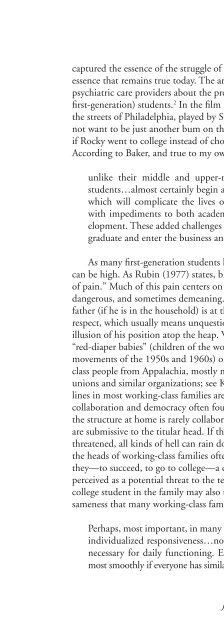WINTER 2012 - National Association of Schools of Public Affairs and ...
WINTER 2012 - National Association of Schools of Public Affairs and ...
WINTER 2012 - National Association of Schools of Public Affairs and ...
You also want an ePaper? Increase the reach of your titles
YUMPU automatically turns print PDFs into web optimized ePapers that Google loves.
Amy E. Smith <strong>and</strong> Ignacio J. Martinez-Moyano<br />
<strong>and</strong> employed a Web-wide participation tool. The electronic Delphi technique<br />
has several advantages. First, the facilitator controls the contributions from<br />
the participants. This reduces some <strong>of</strong> the problems associated with group<br />
dynamics, such as groupthink <strong>and</strong> leader dominance (Janis, 1972; McCauley,<br />
1989; Wissema, 1982). Second, the anonymity <strong>of</strong> the respondents reduces the<br />
b<strong>and</strong>wagon effect (Coleman, 1973), whereby the chances <strong>of</strong> one individual in<br />
the group adopting an idea increases based on who else in the group has already<br />
adopted the idea; <strong>and</strong> the halo effect (Nisbett & Wilson, 1977), whereby the first<br />
characteristics we recognize about an individual influences our interpretation <strong>of</strong><br />
later characteristics <strong>of</strong> that individual. Anonymity also encourages open criticism,<br />
admittance <strong>of</strong> mistakes, <strong>and</strong> revision <strong>of</strong> original stances. Finally, because the<br />
discussion tool was Web based, participants could access the tool at any time,<br />
<strong>and</strong> responses did not have to be completed in one sitting.<br />
While there is ample variation in how the Delphi technique has been<br />
employed, the procedure used in this project was conducted in three rounds<br />
as follows: First, an idea elicitation stage in which the subjects were presented<br />
with the survey questions described in Appendix A was conducted. In this<br />
stage, the respondents generated ideas independently <strong>of</strong> one another, <strong>and</strong> the<br />
ideas generated by all respondents were aggregated in one list. Second, an idea<br />
clustering stage in which the aggregated list was returned to respondents for<br />
grouping based on similarity. A list <strong>of</strong> groups generated by respondents was<br />
created based on grouping agreement among respondents. Third, a cluster<br />
prioritizing stage in which the list <strong>of</strong> grouped ideas was independently evaluated<br />
by the respondents based on relative importance. The resulting groups <strong>and</strong> the<br />
level <strong>of</strong> agreement achieved became the primary portion <strong>of</strong> the analysis. Each<br />
stage <strong>of</strong> the Delphi procedures is discussed in detail next.<br />
To begin the idea elicitation stage, we sent participants an e-mail with a link<br />
to the Web-wide participation meeting. The purpose <strong>of</strong> this step was to elicit<br />
ideas from participants regarding methods to address the challenges inherent in<br />
teaching statistics to students enrolled in practitioner-oriented master’s degree<br />
programs. Participants answered each <strong>of</strong> the four survey questions privately, but<br />
they were given the opportunity to view an anonymous list <strong>of</strong> answers generated<br />
by other participants as these became available. This is similar to a brainstorming<br />
exercise wherein an unlimited number <strong>of</strong> ideas can be generated. The elicitation<br />
stage lasted 3 weeks. During this time, participants generated ideas in response<br />
to each <strong>of</strong> the four questions. At the end <strong>of</strong> the session, the authors compiled an<br />
aggregated list <strong>of</strong> all the ideas produced by participants by question.<br />
After the idea elicitation stage, we began the idea clustering stage. The<br />
purpose <strong>of</strong> this stage was to get participants to examine the aggregate list <strong>of</strong> ideas<br />
(by question for each <strong>of</strong> the four questions asked) <strong>and</strong> cluster these ideas based<br />
on similarity. There were no predetermined clusters. Participants were asked<br />
to cluster ideas that they thought were similar. Participants privately clustered<br />
118 Journal <strong>of</strong> <strong>Public</strong> <strong>Affairs</strong> Education

















